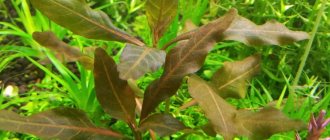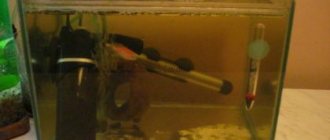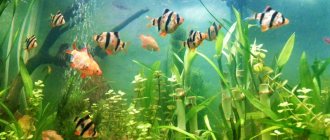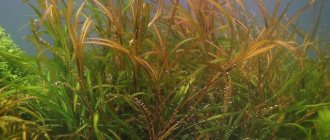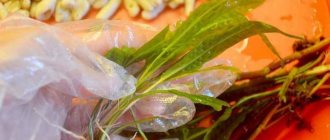Hi all! Recently I asked myself, what is useful to write? And one of the requests was “to recommend low-growing plants for the foreground that do not require co2 supply.” This is the question we will now deal with.
Well, first of all, I would like to touch on the notorious CO2; it seems to me that many people do not fully understand what it is and what it is needed for. I draw similar conclusions from very common questions:
- “Will these plants grow without co2?”
- “Do you grow plants using co2?”
- “But I don’t have co2, will the plants grow?”
My friends, co2 is not the main factor (yes, it’s a good thing, important, necessary, but not the main one) thanks to which plants grow safely! What does co2 give us:
- First of all, this is the growth rate (but we must remember that light and water must always be added to CO2)
- Plants become more beautiful, this is of course an indisputable fact (more fleshy, healthier, more vibrant), but this does not mean at all that without co2 the plants are ugly and not healthy!
- Well, the third plus of co2 is that it acidifies the water and normalizes the pH, which is a very important parameter for aquarium plants.
Well, we’re not talking about co2, I’ll write a separate article about it. We are talking about low-growing plants for the foreground and middle ground in the aquarium that do not require a supply of co2. These plants can be divided into two groups
— Ground cover (forming a mat or lawn)
— Low-growing (no more than 10-15cm in height)
Planning is really very important, since a successful composition with perspective and thoughtful design is not an unimportant step in creating a truly beautiful aquarium. The question of what to put in the foreground and middle ground always arises quite acutely. Because the assortment of unpretentious long stems and large plants (such as echinodorus, nymphs, anubias, etc.) is quite large, but with low-growing species it seems more and more difficult...
But this is not what it might seem at first glance))
The first thing you should pay attention to when choosing plants for the foreground and middle ground is not the light intensity, but the light intensity! LIGHT, light my friends, the most important thing that can be for plants (almost all plants)! If we’re talking about some kind of magical, miraculous remedy that will solve all the troubles in the aquarium, then it’s light. Well, this is of course a joke, I greatly exaggerated)) there is no single magic pill, you always need a complex, but there is a large share of truth in this. Light intensity really plays a leading role for low-growing plants (and not only). Therefore, the fact that you don’t have co2 is not a problem at all, but if there is little light... this factor will significantly narrow the search for plants for the foreground.
Well, let's look in more detail...let's look at them by type. I will focus on unpretentious species. Most of the plants listed below require intense lighting, but I will focus on co2 and other nuances.
Foreground plants for nano aquariums (30-40 liters)
Marsilia four-leaved.
Marsilea quadrifolia
First of all, I would like to highlight Marsilea quadrifolia. Low-growing, unpretentious ground-blood. The plant is so miniature that even in a small aquarium it will look like a groundblood, and this is exactly the kind of aquarium that many beginning aquarists have. It also looks good in large aquariums (200-300 liters).
The plant is a fern with leaves of an original shape, which are located on a creeping rhizome that spreads along the surface of the soil. The height of the plant in an aquarium does not exceed 10-12 cm. For someone who has never seen this plant, it is difficult to understand from the description and photo how it will look in an aquarium. Under normal, rather undemanding conditions, it grows in the form of a green carpet 3-4 cm high. More often it is not a four-leaf clover, but a single, hard leaf the size of a marigold. It is better to plant it with tweezers, each root separately.
A moderately warm aquarium with a water temperature of 18-22 °C is suitable for Marsilia, but the plant can grow well in a tropical aquarium. At temperatures below 16 °C, growth practically stops. The water should be soft with a neutral or slightly acidic reaction. In moderately hard and slightly alkaline water, Marsilia grows very slowly. Changing water does not have a significant effect on its growth.
See the guide for more details...
Start
Sitnyag is tiny.
(Eleocharis parvula (Roem. et Schult.) Link)
The next most capricious one is the tiny one, which also belongs to the group of groundcovers. The stems extend from the rhizome in the form of needle-shaped bunches, (about 0.5 mm in diameter), bright green, 6 - 7 cm high, usually 3 - 4 cm. Looks good in the foreground in any aquarium. And the main leaf is very different from Marsilia quatrefoil. In small aquariums, both species can be combined in the foreground. As a rule, more than 2-3 species are rarely planted in such aquariums.
Belongs to marsh plants, the root system is poorly developed. There are no special maintenance requirements, but it grows better in an aquarium with a low water level. It reproduces by ground shoots that extend from the rhizome and grow at a considerable distance from each other. Lighting should preferably be moderate, water temperature 23 °C in summer, 17 - 19 °C in winter.
Start
Glossostigma militaria.
Glossostigma elatinoides
Family Scrophulariaceae. Distribution: Australia, New Zealand, Tasmania. A very light-loving plant that can only be recommended to an experienced aquarist, plant height 2 - 3 cm dGH 5-7.5 Water temperature 22-26 ° C. The leaves are more delicate than those of Marsilia and a little smaller, about the size of a little fingernail. A marsh plant with creeping, often branching shoots that take root at all nodes. Petiole up to 2.0 cm, leaves opposite. An elegant, well-growing plant.
When illuminated at high intensity, the shoots are creeping; when there is a lack of light, they tend upward. Therefore, shallow, well-lit aquariums are recommended for culture. For good growth, soft, slightly acidic water is optimal. Planting in fine sand soil is recommended with tweezers, each root separately, requires some patience and must be done with caution. It grows in swampy areas, rivers and lakes, often completely under water.
Start
Cryptocarina Beckett.
Cryptocoryne becketii or Cryptocoryne petchii
Dark olive leaves with reddish-brown undersides arranged in small rosettes. The plant forms loose thickets 10-12 cm high. Cryptocoryne should be placed in the foreground of the aquarium. It grows evenly throughout the year. Somewhat larger, but the leaves creep, and differ in color and shape from previous plants. Unpretentious, but grows slowly.
Cryptocoryne Beckett prefers a warm aquarium. The optimal temperature is 24-28°C. Cryptocoryne can be kept at a temperature of 20-22°C, but its growth slows down significantly. Water hardness should be in the range of 8-16°, it increases at 5-6°, but the growth slows down. In softer water the plant may be susceptible to cryptocoryne disease. The active reaction of water should be neutral or slightly alkaline. With a sharp shift in pH towards increased acidity, cryptocoryne can shed all its leaves. If the alkalinity of hard water increases, this usually does not harm the plant.
Lighting when keeping this cryptocoryne can be moderate or quite strong and necessarily diffused. If the light is direct, it is better to shade the plant. Cryptocoryne Beckett grows very well in the light shade of taller plants. For artificial lighting, LB type fluorescent lamps should be used in combination with incandescent lamps. Their power is determined individually in each specific case and depends mainly on the neighboring plants and the planting density of the aquarium. Daylight should be 11-12 hours.
See the guide for more details...
Start
Java moss.
Vesicularia dubyana
It is an interweaving of thin threads of dark green color, tightly attached to the irregularities of stones and driftwood. A plant that is not disturbed for a long time forms very beautiful thickets. There are many varieties of mosses, but Java moss is one of the few that has roots, which makes it possible to plant it in the ground. Moss can be used as a spawning substrate for many fish. The plant is very unpretentious and therefore widely distributed among aquarium enthusiasts. Java moss grows slowly but evenly throughout the year.
The optimal temperature for keeping this plant ranges from 24 to 28°C. At temperatures below 22°C, its growth practically stops. The hardness and active reaction of the water does not matter: Java moss grows satisfactorily in both very soft and hard water with an acidic and alkaline reaction. The water should be clear. In muddy water, a coating quickly forms on the moss, which not only spoils the appearance of the plant, but also disrupts its nutrition. Regular water changes in the aquarium are not necessary, since moss develops satisfactorily in old water.
The nature of the lighting and its intensity do not play a big role. The plant can withstand prolonged shading and can grow with minimal light. In bright light, the moss takes on a rich green color, and the threads begin to branch. At the same time, the thicket becomes dense and has a very attractive appearance.
See the guide for more details...
Start
Cryptocoryne is small.
(Cryptocoryne minima)
Grows along the banks of slow-moving streams and is well shaded by large plants. The leaves are oval-lanceolate, rounded at the base, and smoothly narrow towards the apex and become a point. Leaf length up to 5 cm, width 1.5 cm, with petioles 8 cm.
The upper side of the leaf is light chocolate color with a very pleasant shade of color (according to Zhdanov’s reference book, Medium-dark green Christel Kasselman), the lower side is violet-crimson, the edges are slightly wavy, the main vein is well expressed, the lateral veins are weak. The leaves sit on short brown petioles.
Water: 22-28° C. Planted in a group in the foreground. Produces many creeping shoots. This plant is best cultivated in a humid greenhouse, but it also grows well in a shallow aquarium submerged in soft water and moderate light. It is advisable to add fatty clay to the soil (it also grows in regular soil, but more slowly). It reproduces vegetatively, but very slowly; during the year you can get up to 5 ground shoots, which also develop slowly. Daughter plants emerge from the soil in close proximity to the mother plant. Overgrown plants are very decorative.
See the guide for more details...
Start
Pogostemon Helferi.
(Pogostemon Helferi)
A very interesting plant for the foreground, especially with its unusual shape
, which will allow you to add some variety to the composition. Pogostemon Helferi resembles a micro “long stem” with wavy, curly, light green leaves, 5-6 cm high. This plant can be very decoratively used to decorate the foreground of an aquarium. However, this plant is not recommended for small aquariums (30-40 liters), as it is very sensitive to changes in water parameters. Especially nitrates, you can gradually increase nitrates as much as you like. The plant should be planted in an established aquarium with a stable environment. It is difficult to create such conditions in a small aquarium.
The plant loves very bright light, although in nature it grows in different conditions, in addition it requires the supply of CO2, and feeding with micro- and macroelements. It feeds mainly on horses and requires rich soil. When all conditions are met, the plant forms many side shoots and creates a very unusual, decorative carpet of vegetation. In combination with other plants, it looks very impressive in the foreground.
Despite all the benefits, this plant can only be recommended to aquarists with experience in keeping an herbalist. Pogostemon Helferi must be cleared of algae, cannot be replanted frequently, requires frequent care, and is also very popular with herbivorous fish. Growth rate is average, grows well at pH = 7 and dKH = 4°. However, in a well-established herbalist, most of the necessary conditions are already met, or they are not difficult to create for the successful cultivation of Pogostemon helferi.
Start
See the guide for more details...
Hemianthus calitrichoides Cuba.
(Hemianthus callitrichoides Cuba)
Distribution: South America, Cuba.
Hemianthus Cuba is a very beautiful and unusual foreground plant in small aquariums. Cuba is a miniature long stem with light green leaves, the leaves are rounded, somewhat lighter than those of Hemianthus micranthemoides. Hemianthus Cuba should be planted with tweezers, one stem at a time, burying it in the ground for its entire length, leaving only the tops on the surface, otherwise the plant may float. Planting density is no more than one bush per square centimeter. The plant grows quickly and forms a dense, very beautiful carpet. The plant quickly grows in length and begins to creep, as if spreading roots from the stem.
However, novice aquarists should not rush to acquire a Cuba. The plant is a bit complicated for a beginner; it requires several conditions to be met at once:
Lighting is very, very strong, at least 0.5 W per liter, and this is very conditional; it should be selected individually for each aquarium. If there is not enough light, the cube becomes smaller and will die after a while.
Nutritious soil, it is advisable to use a special substrate and fine soil.
The addition of fertilizers to water is strictly dosed; it loves iron, otherwise it turns yellow and pale, and if overdosed, it darkens and becomes shallow. But when normal conditions are restored, it quickly recovers.
Filtration, the water must be clean and water changes are necessary, otherwise it will become overgrown with algae and die, it is necessary to regularly clean it of threads. Water flow is desirable, but it is not necessary to create a strong current. The main thing is that dirt does not accumulate on the plants.
Other conditions are not demanding, water parameters pH from 6.5; under fairly good other conditions, it bubbles even without CO2. For a well-established herbalist, the conditions of detention are quite normal, perhaps even simpler than for Pogostemon Helferi.
Start
Placing aquarium plants in containers
It may turn out that when planting aquarium plants, some species may need different types of soil. This problem can be solved by planting plants in ceramic pots of the appropriate size. Moreover, it makes sense to use large pots in large-volume aquariums where they are easier to decorate.
In small and medium-sized aquariums, their use can ruin the entire look. Therefore, in such tanks it is better to place plants in transparent ditches that are practically invisible. If necessary, the cuvettes can be easily moved inside the aquarium. The use of such ditches and clay pots allows plants to be planted in a variety of substrates, which can be ordinary river sand or a specially selected soil mixture.
If the use of containers is not intended for aesthetic reasons, then special partitions made of natural materials or glass can be used aquarium plants In this case, in addition to using different soils, the substrate can be laid at different levels.
Foreground plants for aquariums from 150-200 liters in size.
Echinodorus tender or Echinodorus herbaceous.
(Echinodorus tenellus.)
A very popular foreground aquarium plant.
, forming dense thickets of dense bright green rosettes of elongated leaves that do not have cuttings. Thickets of Echinodorus tender, 7-10 cm high, placed in the foreground, perfectly decorate the aquarium. — The growing season continues all year round. The plant is undemanding to living conditions.
The temperature of the water in which Echinodorus tenderus is contained can fluctuate within very wide limits, from 18 to 30°C, optimal conditions are created at 24-26°C. The preferred water hardness is more than 4°. In very soft water, old leaves are quickly destroyed. The active response can vary widely.
Echinodorus feels somewhat better in a neutral and slightly alkaline environment. It is advisable to change the water regularly. Echinodorus tender requires strong lighting. In bright light, the plant acquires a bright color, the bushes become low and dense. With insufficient lighting, the leaves begin to stretch upward and acquire a light greenish-yellow color. Even a small amount of natural light entering the aquarium significantly improves the condition of the plant.
The soil layer can be minimal, 2-3cm. Mineral feeding is required only in a very densely planted aquarium. Each bush very quickly forms 2-3 tendrils, on which young plants appear one after another. Such a mustache with 2-3 daughter plants can be separated from the mother bush and planted in a new place. Under favorable conditions, young plants are quickly accepted and form a new thicket in 1.5-2 months.
See the guide for more details...
Start
Echinodorus four-ribbed.
(Echinodorus quadricostatus.)
In an aquarium, it is best to place it in the foreground or middle ground.
The height of the plant is 5-10 cm. The thickened rhizome holds firmly in the ground. The terrestrial form of the plant, whose height is about 10 cm, has leaves that are petiolate, dark green, oval, narrowed at the base and apex, 4 cm long and 10 mm wide. A plant grown in water has thin, green, filmy leaves with short petioles, oval, narrowed at the base and apex, with faint veins, 15 cm long and 2 cm wide. The plant reproduces most quickly by creeping shoots and forms continuous thickets. It is not demanding on the quality of the soil; it can be planted in ordinary aquarium soil, which is sufficiently silted. Grows well in an aquarium in medium light in neutral water of medium hardness.
See the guide for more details...
Start
Anubias dwarf.
(Anubias nana Engler.)
This miniature foreground plant is common in the rainforests of Cameroon.
Although, in comparison with the same Marsilia, in small aquariums of 20-30 liters it can also be used in the middle ground. In aquariums it grows up to 10 cm in height. Requires shading and high humidity. The rhizome is creeping, sometimes branched. The leaves are petiolate, simple, up to 8 cm wide and up to 2.5 cm wide, lanceolate, collected in a rosette, dark green, narrowed at the base and towards the apex; The venation is pinnate, the main vein protrudes from the lower side, the lateral ones are inconspicuous. The flowers are collected in an inflorescence-cob, the ovary is surrounded by a pale green funnel-shaped blanket.
This plant grows well in a moist, warm greenhouse with indirect light. It can also be kept in an aquarium, water hardness 2-16°, pH 6-8. Conditions for keeping and breeding are the same as for the species of this genus discussed above. In aquariums it grows more slowly, the lighting is moderate, but in the case of the spread of “beard, flip flops”, it settles on the leaves of Anubias first.
All plants of the Anubias genus are beautiful and unpretentious. They can decorate any tropical aquarium with moderate lighting. Under normal conditions, leaves last 1-2 years, which is rarely the case with other plants.
See the guide for more details...
Start
Decoration of aquarium decoration elements
First, driftwood and large stones are decorated with plants. It is best to do this in an aquarium that is not filled with water, since in the process of attaching plants you may need to move the decorations many times, which is not very convenient to do in an aquarium filled with water. Various types of mosses and ferns are best suited for placement on driftwood and stones. They are secured with a nylon thread, which usually collapses after two weeks. And during this time, plants usually have time to attach their roots to the decorative object.
Beautifully decorated aquarium with driftwood and large stones
To attach moss, you can also use a thin transparent fishing line; such fastening is almost invisible from the very beginning, and after some time it is completely overgrown.
After decorating the decorations, we begin to pour water, we do this in several stages, so that with each subsequent planting the water slightly covers the planted aquarium plants .
It is not recommended to plant a large number of different types of plants in an aquarium. No more than one species should be placed on a bottom area of 2-3 dm2.
